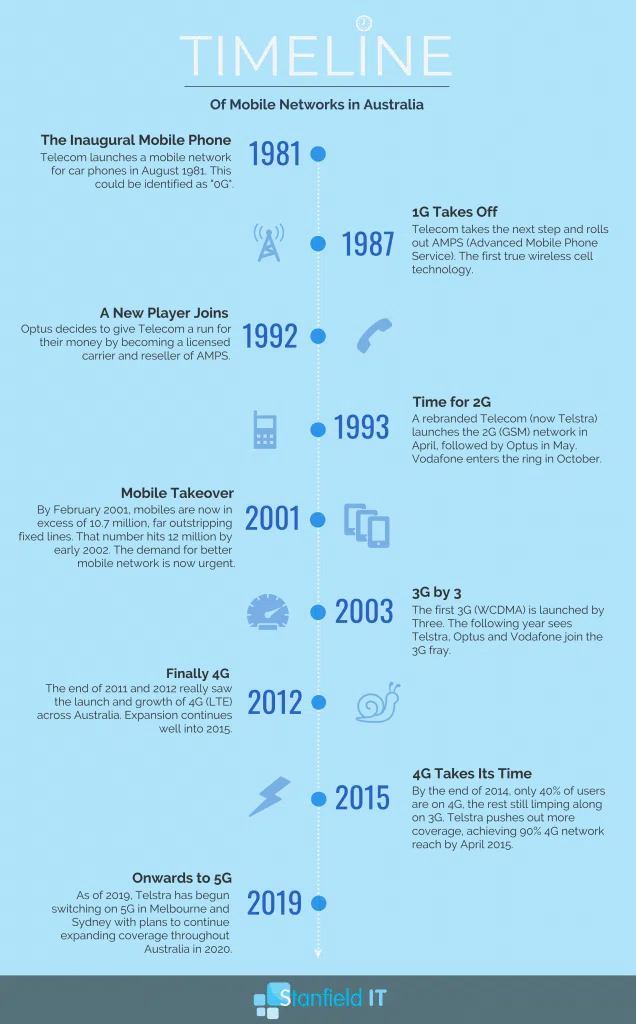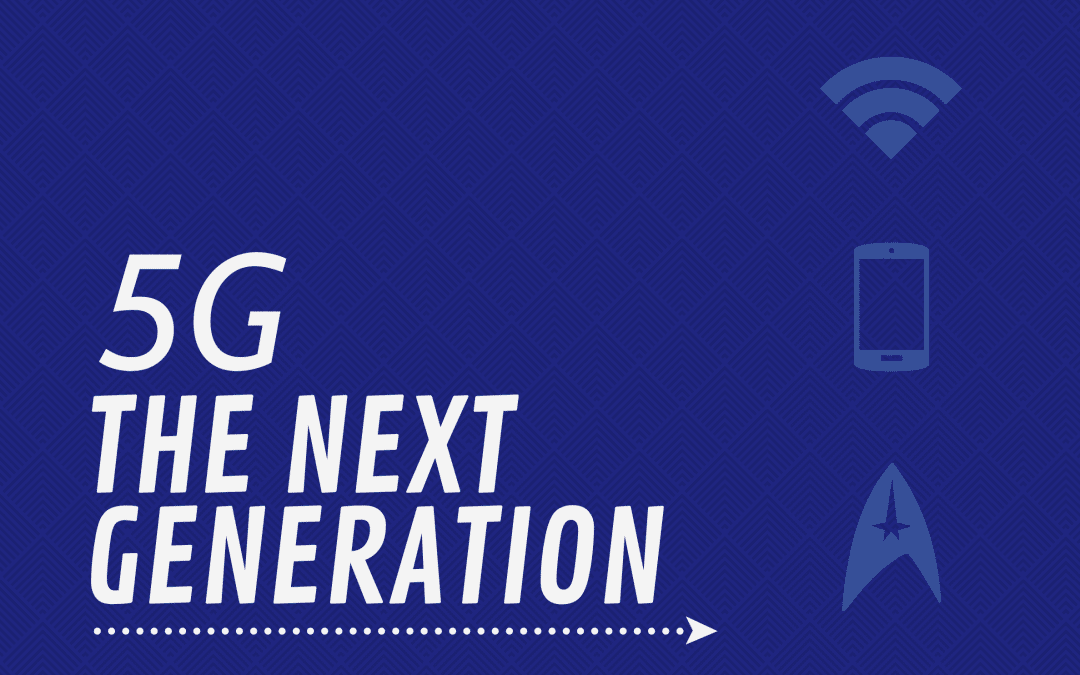By 5G, of course we’re discussing mobile internet, not the force of gravity you’d experience in a spinning fighter jet. We’re going to assume you’re familiar with 3G, and 4G. Unless you’re from 2006 before smartphones took over our lives. But that seems unlikely. So we’ll carry on with our initial assumption. It only stands to reason that after 3G and 4G, comes 5G. Aka, the 5th Generation of cellular network technology.
The fabled 5G network has been in the works now for nearly a decade — ever since 4G began to rollout, really. But first, let’s have a quick look at the timeline of mobile networks in Australia.

5G In Depth
Aside from the obvious benefit of vastly improved speeds, there are some things to consider with the new 5G network. Let’s discuss the burning questions on everyone’s mind:
Will 5G Replace Fixed Internet?
It might seem far-fetched, but there is a lot of talk about 5G replacing fixed broadband services. This is primarily due to its fast speed, efficiency and virtually real-time communications. Is this really the case, however?
‘Experts’ said the same thing about 4G when the buzz first began, nearly a decade ago. But as we’ve since seen, 4G was hardly the answer to our fixed broadband prayers. While providing a significant boost to 3G services, there’s no chance it was ever a complete replacement for broadband in the office. What makes 5G any different?
Increased Bandwidth = Faster Transmissions
5G is gearing up to be crazy fast in comparison to 4G. Mobile broadband utilises radio frequencies to transmit data, and 5G resides in the 24GHz to 100GHz range, meaning greatly increased bandwidth. For comparison, 4G sits around 700MHz to 2100MHz range. Greater bandwidth is more about how much data is transferred at once, rather than the speed at which it is transferred. It’s rumoured to be capable of up to 10-20 gigabits per second (depending who you ask). This is at least 100 times faster than the best that NBN has to offer right now. So you can see where this speculation is coming from. However, those speeds are still some time away.
Wired > Wireless
Another roadblock to consider is the fact that wired connections almost always trump wireless. Wireless connections (like 5G) are subject to traffic congestion, and interference more so than fixed lines. Wireless networks, ie connections that rely on over-the-air transmissions, are subject to significant variations in network speed due to interference. This is because the network is a shared spectrum, meaning that if you’ve got a lot of users on that space, then the network becomes congested and you’ll find the connection struggles to maintain any serious speed.
More Towers Required
To summarise and simplify, mmWave is the new technology that powers 5G. This is able to broadcast high speed/low latency connections. However, mmWave has more distance limitations and is easily blocked by physical interference such as buildings, trees or rain. Since mmWave coverage sits somewhere around 500m to 1km, we would require significantly more towers to create effective coverage within populated areas. Its also less likely to be rolled out as thoroughly in more rural areas. There is a workaround to this issue being developed, but it more or less seems to be ‘add more cells’ and extra transmitters to bounce the signal around.
So, Does 5G Supercede Fixed Broadband?
Ultimately, it seems that no, 5G will not replace fixed internet connections. There are too many interference and distance limitations currently restricting 5G capabilities. Not to mention that we will likely be well into the 2020s before we see a real mainstream penetration of 5G coverage (if you consider how long it took for 4G to fully expand). So, it seems that the fixed connection (à la NBN) and fibre have a secure place in our network needs for the foreseeable future. It does seem that 5G is better considered as a complementary option to be paired with NBN and fibre connections, utilising an SDWAN connection.
When Will 5G Be Available?
Telstra announced in December 2018 that they had switched on 5G in Melbourne and Sydney in anticipation of 5G devices becoming available in the next 12 months. Of course, 5G-capable devices are not currently on the market, so consumers will still have to wait before being able to take advantage of the new network.
Optus is already offering a plan for 5G home broadband though it’s only currently available in limited areas. Though again, consumers need to wait for a 5G device before being able to utilise this connection. Telstra and Optus have both committed to selling 5G services in 2019, and Vodafone is expected to follow in 2020.
Regarding 5G compatible devices, Huawei may be the first company to launch a 5G phone around mid-2019. Apple, as always, remains tight-lipped on future devices. But based on previous phone launches, a 5G capable iPhone can probably be expected around 2020.
What Are The Implications of 5G?
So far, it seems like the fuss around 5G is a little overrated, but there are some possibilities that warrant the excitement.
1. Self-Driving Cars
With the near instantaneous data transfer that 5G offers, this has great implications for autonomous vehicles. Where 4G has a response time of about 45 milliseconds, 5G can reduce that to just 1 millisecond. Those precious milliseconds mean that the driverless car is able to respond to the traffic ahead, whether it’s a car turning or suddenly stopping. The safety and responsiveness of these cars will be far more assured under 5G technology.
2. Remote Surgery
One of the biggest perks of 5G that we briefly mentioned earlier; is its ultra low latency. This has enormous significance for healthcare and surgery. 5G offers the possibility for long-distance surgery. A specialist surgeon at the top of their field could potentially perform life-saving operations from across the country as the low latency enables actions to be performed in real-time.
3. Internet of Things
5G also has a positive impact on the rapid-growing Internet of Things environment. Currently, the devices are able to communicate with one another, but this communication chews up a lot of resources and depletes 4G data capacity. With 5G on scene, the IoT won’t be such a drain on network resources and therefore much more efficient.
4. Augmented Reality
Augmented reality and virtual reality devices have been on the market for many years now, but if you’ve ever tried such a device, you’ll know they’ve never been truly immersive. A 5G network would provide the required bandwidth and low latency to make AR/VR experiences truly seamless and real. True VR and AR has potential in physical therapy, and innovative classroom learning.
5. Operate Heavy Machinery
Again, the low latency of 5G will enable the remote control of heavy machinery which reduces the risk to human operators working in hazardous conditions and also enable specialised technicians to control machinery from any location with immediate responsiveness.
Conclusion
With all said and done, we’re wondering how you feel about 5G and the possibilities that come with it.
– What 5G possibility are you most excited about?
– Do you think that 5G will eventually overtake fixed internet?
– Do you think 5G is really essential for the future of communications in Australia?
– Did we miss any major factors that we definitely should have covered?
Whichever side of the fence you sit on, it’s clear that 5G is stirring up a lot of buzz, and time will ultimately tell if it’s going to be the revolutionary game-changer it’s currently cracked up to be. At Stanfield IT, at least, we’re excited to see what possibilities lay in store for information security, and how 5G can change things like mobile device management for the better.
